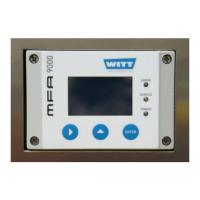Page 10 of 46
WITT-GASETECHNIK GmbH & Co KG
Gas Safety- & Control Equipment
5 Set up and installation
In this section you will find information on the proper location for setting up the gas analyser, and
notes on both the gas and the electrical installations.
5.1 Checking for transport damage
Please note !
Never transport the system in a tilted position. Perform a visual inspection for external
damage and damage to cables (nicks, damage to the insulation).
The gas analyser is supplied ready to use. It must be correctly transported.
5.2 Location for setting up
Please note !
Never expose the instrument to direct sunlight or large amounts of heat.
Please note !
Do not operate the instrument in an environment with increased electromagnetic activity
(outside the standardised limits).
Please note !
Observe safety distances when setting up.
The analyser should remain accessible for servicing.
place the undamaged instrument on a solid surface in a place protected from the weather and
secured against accidents.
during setting up observe the ambient conditions specified in the Technical Data (section 9)
(e.g., ambient temperature, a safety zone, humidity, dust, altitude).
5.3 Safety instructions for installation
Warning !
Prior to initial commissioning and after modification, repairs, or expansion of the system /
unit, the safety checks required by BGV A3 (reference to DIN VDE 0100, DIN VDE 0701, DIN
VDE 0702, etc.) are to be performed and logged. The checks encompass the inspection,
testing, and measuring of the effectiveness of protective measures (e.g. emergency stop
devices, interlocks, pressure switches, etc.).
If the operating organisation is not in a position to perform a check, a check in accordance
with DIN VDE 0702 can be performed by WITT Service.
Warning !
In accordance with BGV A3 a protective earth connection (PE connection ) of protection
class 1 must be provided.
Warning !
Following initial commissioning and after modification, repair, or expansion of a system /
unit, the connections and joints are to be checked for leaks to the atmosphere with inert
gas. For this process only use suitable leak testing procedures (never test with a naked
flame). If you find leaks, rectify them immediately; the applicable safety regulations are to be
observed during this process.
Warning !
The material for the gas pipes (pipes from the gas supply to the inlets on the gas analyser),
all fittings installed there (e.g. shut-off valves, manometers, etc.) and all sealing elements
there must be designed for the related type of gas.

